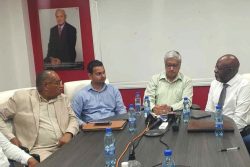One looked in vain for any comprehensive contribution from Minister of Culture, Youth and Sport Charles Ramson during the Budget debate on cultural matters. He expounded at length on topics such as the transformative nature of the Budget, house lots and the fact the PPP/C would honour every promise made in its manifesto. It might be noted, however, that there was nothing much of substance on the matter of culture in the manifesto, but then politicians never have that very high on their list of priorities.
When the Minister did get around to his own portfolio, he was far more voluble on the sport element of his responsibilities than the others, adverting to the significant efforts the government had been making to develop community grounds and various sports facilities. This would continue, he indicated, telling the House, “I’m pleased as well to announce … that in this year’s budget there will be $250 million in our budget for ground enhancement.” For the sport sector, he said, “the budget is $3.15 billion with a capital of $2.4 billion …”
And what about culture? That appeared to galvanise him far less. Last Friday his Ministry provided a cultural and creative grant to 20 young Guyanese valued at $1 million each to give them an opportunity to share their talents through the creative industry. “This may seem as though it is a moment for you to share in the success of the country and the success of our creative industry,” he said; “It’s also creating a form of a new pillar of our diversification, which is going to be an important component of us as a country, as a people, because that’s what culture is about, culture is about who we are and when people come to our country, we have to be able to tell that story.”
Culture, of course, is a vague concept covering a variety of areas and the Minister seemed mainly concerned by what might be termed in a larger sense its performance aspects, although in the case of the grants to young people, he might have married those to the objective of youth development. In an appearance on NCN Mr Ramson said that his Ministry planned to ensure there was a mixture of cultural activities at every national event, particularly religious events. We needed to share our culture with the world, he said.
Minister Ashni Singh in his Budget presentation did seem to suggest the government as a whole had a more expansive definition of what was encompassed by culture than that to which Mr Ramson had confined himself. In his presentation on Budget Day he said that over $120 million would go towards infrastructural development for the progress and preservation of culture and arts, in addition to which $36 million would be provided for the upgrade of heritage sites at Fort Nassau, the Dutch Heritage Museum and the Indian Arrival Monument at Palmyra.
He also made known the government’s intention to draft a National Cultural and Creative Industries Policy to guide the sector’s development as well as re-establish the Advisory Boards for the National Gallery of Art and the National Archives. In addition the plan was, he said, to update the National Trust’s legislation to bring it into alignment with present-day trends in heritage preservation. Added to that we reported him as announcing that $30 million had been allocated for grants to the cultural and creative industries which would focus on original cultural and creative products. Where this was concerned it seems he had commercial benefit in mind.
It is about time that the Advisory Boards were reinstated particularly in the case of the Archives, which hasn’t had one since the time of one of the earlier PPP/C’s administrations. As for creative industries which might generate profit, it has to be pointed out that this country has little copyright protection, an omission which previous governments have refused to remedy. No one with literary ambitions at any level is going to expose their creativity here to being copied by all and sundry. And then there is the Guyana Prize for Literature, which was inaugurated in 1987 and quietly abandoned during the coalition’s tenure in 2015. Will Minister Ramson be prepared to resuscitate that?
It is good that Minister Singh was prepared to pay some attention to our material heritage, although the scope of what he had in mind was very limited. Our material heritage is not like that of Paramaribo, say, or Barbados with its planter houses among various other things dotted around, but there is still a great deal which needs our attention, and which could attract tourist interest if we only knew how to go about it. We have been closing down sugar estates, for example, but why is it that in a country which produced more sugar in the 19th century than any other territory in the British Caribbean we have no sugar museum on any of these former plantations? There could be logies and reconstructed factory and other buildings as well as planter residences. Visitors could be taken on the pontoons around a small section of the ‘estate’, etc. Apart from being a learning experience for children, it would inevitably attract tourists.
During his period in office Minister Ramson has had nothing to say about a museum policy in general. Former President David Granger to his eternal discredit decided to move everything out of the Walter Roth Museum to the National Museum because his government wanted the space next to State House. There was no consideration for whether there was room for the artefacts in their proposed new abode, and no experts were contacted about whether it was even advisable or possible to transfer some of the holdings. Fortunately he was dissuaded from pursuing that proposal, but his attitude was a reflection of his apparent disinterest in museums.
PPP/C governments it must be said, have done no better. All the museums in this country need overhauling and brought into line with modern approaches so they really function as exciting learning centres for students that can also attract tourists. The story of the 150 year old National Museum is a sad one, and someone with expertise needs to lead discussions among experts and interested parties about what we should be seeking to achieve, not just in this case, but with museums as a whole.
National days and heritage months are the exemplars of governments’ attitude to culture in this land; they involve public display with which ministers can associate themselves, but are generally not unduly demanding on funding resources. Ministers are never heard on the hustings, for instance, promising funds for the National Library, the National Gallery, any museum, or indeed the National Trust. These are not institutions, they feel, about which the public at large is concerned.
And here we are in an oil economy with government making all kinds of promises in all kinds of areas, but while there has been some small improvement, what is going to culture in its widest sense is parsimonious, especially in comparison with the positive largesse from which the Sport sector has benefited. In fairness, what we need first is a cultural policy covering all departments, and hopefully that is what is intended by the National Cultural and Creative Industries Policy, although since it is not spelt out one cannot be certain. Only when there is a series of policies covering all areas, such as, for example, the material heritage, the housing and repatriation of rare books on Guyana, art, literature, etc, would it then become possible to argue for funding in each of the sectors.
The cultural image of a nation does not lie in its heritage days – or at least, only in a minor way – but in its literary traditions, in its libraries containing the works of those who have gone before, in its art as well as its craft traditions, in its material heritage, in its sense of and sensitivity to its past and the acknowledged achievements of the forebears. In a multi-cultural society like this one, there are any number of other intangible aspects of the heritage such as the variety of languages and cultural norms.
Minister Ramson is no doubt inexperienced in this field, and perhaps could begin by initiating discussions with a wide variety of people involved in culture at one level or another. If we don’t manage to develop a coherent cultural policy which can be implemented, we won’t have a culture to share with anyone. If we do use our imaginations to become creative about our culture, we will be acting not just for ourselves, but also for those who come after us.





